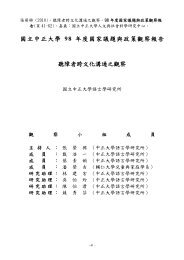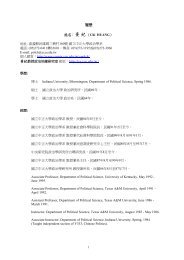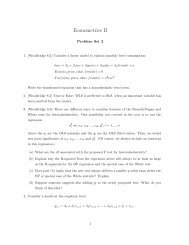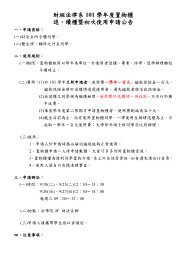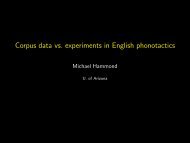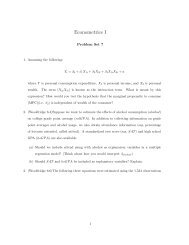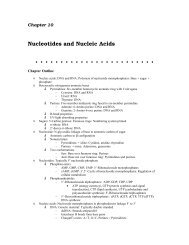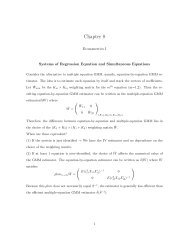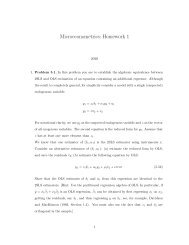A usage-based account on verbal reduplication in Taiwan Southern ...
A usage-based account on verbal reduplication in Taiwan Southern ...
A usage-based account on verbal reduplication in Taiwan Southern ...
You also want an ePaper? Increase the reach of your titles
YUMPU automatically turns print PDFs into web optimized ePapers that Google loves.
A <str<strong>on</strong>g>usage</str<strong>on</strong>g>-<str<strong>on</strong>g>based</str<strong>on</strong>g> <str<strong>on</strong>g>account</str<strong>on</strong>g> of <strong>verbal</strong> reduplicati<strong>on</strong><br />
<strong>in</strong> <strong>Taiwan</strong> <strong>Southern</strong> M<strong>in</strong><br />
Hui-Ju Chuang & James H-Y. Tai<br />
Nati<strong>on</strong>al Chung Cheng University<br />
asthjc@ccu.edu.tw<br />
Abstract<br />
Verbal reduplicative c<strong>on</strong>structi<strong>on</strong> (VRC) <strong>in</strong> <strong>Taiwan</strong> <strong>Southern</strong> M<strong>in</strong> (TSM) is highly<br />
productive and is manifested <strong>in</strong> its own fashi<strong>on</strong> <strong>in</strong> prosodic/ph<strong>on</strong>ology, syntax, semantics<br />
and pragmatics. Under the framework of c<strong>on</strong>structi<strong>on</strong> grammar, we propose that TSM VRC<br />
forms a family of c<strong>on</strong>structi<strong>on</strong>s, compris<strong>in</strong>g various subtypes of VRCs, which are l<strong>in</strong>ked up<br />
by <strong>in</strong>heritance relati<strong>on</strong>s. Further, we claim that the XX le 0 VRC is the most prototypical<br />
c<strong>on</strong>structi<strong>on</strong>, and others <strong>in</strong>herit the schema from it. F<strong>in</strong>ally, build<strong>in</strong>g <strong>on</strong> a <str<strong>on</strong>g>usage</str<strong>on</strong>g>-<str<strong>on</strong>g>based</str<strong>on</strong>g><br />
<str<strong>on</strong>g>account</str<strong>on</strong>g>, we show some evidences that XX le 0 VRC occurs the most frequently and, thus,<br />
the most entrenched am<strong>on</strong>g other TSM VRCs.<br />
Keywords: <strong>verbal</strong> reduplicative c<strong>on</strong>structi<strong>on</strong>, <strong>Taiwan</strong> <strong>Southern</strong> M<strong>in</strong>, c<strong>on</strong>structi<strong>on</strong> grammar,<br />
a <str<strong>on</strong>g>usage</str<strong>on</strong>g>-<str<strong>on</strong>g>based</str<strong>on</strong>g> <str<strong>on</strong>g>account</str<strong>on</strong>g><br />
1. Introducti<strong>on</strong><br />
Reduplicati<strong>on</strong> is a comm<strong>on</strong>ly seen l<strong>in</strong>guistic phenomen<strong>on</strong> across different<br />
language families, such as S<strong>in</strong>o-Tibetan, Indo-European, Australasian families and<br />
many others. As a morphological process, reduplicati<strong>on</strong> operates cross-l<strong>in</strong>guistically<br />
<strong>on</strong> nouns, verbs, adjectives, adverbs, and classifiers. The worldwide distributi<strong>on</strong> of<br />
reduplicati<strong>on</strong> also shows diversity of mean<strong>in</strong>gs. Mean<strong>in</strong>gs expressed by the<br />
reduplicated forms, as suggested <strong>in</strong> previous studies (Haiman 1980, Moravcsik 1987,<br />
Tai 1993, Huang 1996, Regier 1998, and Zhang 1999), are enveloped <strong>in</strong> the mean<strong>in</strong>gs<br />
of “repetiti<strong>on</strong>” (e.g., M<strong>on</strong>golian bayn bayb ‘often, c<strong>on</strong>stantly’ (Regier 1998)),<br />
“plurality” (e.g., Tagalog araw araw ‘every day’ (Blake 1917)) (cite from Moravcsik<br />
1987: 318), distributivity (Mandar<strong>in</strong> renren ‘everybody’ Tai (1993)), “<strong>in</strong>tensity” (e.g.,<br />
Thai didii ‘to be extremely good’ (Haas1946)) (cite from Moravcsik 1987: 321),<br />
“attenuati<strong>on</strong>” (e.g., Swahili maji-maji ‘somewhat wet’ (Asht<strong>on</strong> 1952)) (cite from<br />
Moravcsik 1987: 323), and so forth. Although the reduplicati<strong>on</strong>s are varied <strong>in</strong> forms<br />
and mean<strong>in</strong>gs, they are, however, triggered by different ic<strong>on</strong>icity motivati<strong>on</strong>s.<br />
(Haiman 1980).<br />
The purpose of this paper is to identify different types of <strong>verbal</strong> reduplicati<strong>on</strong><br />
- 1755 -
found <strong>in</strong> <strong>Southern</strong> M<strong>in</strong> (a Ch<strong>in</strong>ese dialect/language) as spoken <strong>in</strong> <strong>Taiwan</strong>. It will be<br />
shown that <strong>verbal</strong> reduplicati<strong>on</strong>s <strong>in</strong> <strong>Taiwan</strong> <strong>Southern</strong> M<strong>in</strong> (TSM) corresp<strong>on</strong>d to<br />
different but related ic<strong>on</strong>ic motivati<strong>on</strong>s, and can be c<strong>on</strong>strued as related c<strong>on</strong>structi<strong>on</strong>s.<br />
Furthermore, <str<strong>on</strong>g>based</str<strong>on</strong>g> <strong>on</strong> the frequency count of the five types of <strong>verbal</strong> reduplicati<strong>on</strong>s<br />
<strong>in</strong> TSM, it is to be dem<strong>on</strong>strated that these <strong>verbal</strong> reduplicati<strong>on</strong> c<strong>on</strong>structi<strong>on</strong>s also l<strong>in</strong>k<br />
up as a family.<br />
2. Verbal reduplicati<strong>on</strong> <strong>in</strong> <strong>Taiwan</strong> southern M<strong>in</strong><br />
It is proposed by Tang (1992) that reduplicati<strong>on</strong> can be divided <strong>in</strong>to two types.<br />
One type of the reduplicati<strong>on</strong> is called “morphological reduplicati<strong>on</strong>”, <strong>in</strong> which the<br />
reduplicati<strong>on</strong> is unproductive, irregular and unpredictable. The reduplicati<strong>on</strong> for this<br />
type is obligatory s<strong>in</strong>ce the reduplicated part together with its n<strong>on</strong>-repeated part can<br />
be taken as a lexical word. In TSM, some adjectives and verbs as well, fall under this<br />
category (e.g., ang 5 ki 3 ki 3 ‘very red’, kik 4 thui 5 thui 5 ‘pretend dull’). The other type of<br />
reduplicati<strong>on</strong>, <strong>on</strong> the c<strong>on</strong>trary, is productive, regular and predictable. This type of<br />
reduplicati<strong>on</strong> is subject to syntactic regulati<strong>on</strong>, also called “syntactic reduplicati<strong>on</strong>”,<br />
which will be dealt with <strong>in</strong> this paper. In TSM, verbs can be simply grouped <strong>in</strong> a<br />
general way by the number of syllables, m<strong>on</strong>osyllabic and disyllabic. For<br />
m<strong>on</strong>osyllabic <strong>verbal</strong> reduplicati<strong>on</strong>s, five types of post<strong>verbal</strong> elements are taken after<br />
the reduplicated verbs, as shown below.<br />
(1) cau 2 cau 2 le 0 (f<strong>in</strong>al particle le 0 )<br />
run-run PTC<br />
‘to run for a little while’<br />
(2) ciah 8 ciah 8 tiau 7 (phase complement)<br />
eat-eat away<br />
‘to eat up (someth<strong>in</strong>g)’<br />
(3) i<strong>on</strong>g 7 i<strong>on</strong>g 7 hai 7 khi 3 (resultative complement)<br />
use-use<br />
break-away<br />
‘to be broken because of over use’<br />
(4) se 2 se 2 hoo 7 ch<strong>in</strong>g 1 -khi 3 (causative complement)<br />
wash-wash CM clean<br />
‘cause (someth<strong>in</strong>g) to be clean by wash<strong>in</strong>g’<br />
- 1756 -
(5) cu 2 cu 2 cit 8 -tua 7 -tui 1 (quantifier complement)<br />
cook-cook <strong>on</strong>e-big-heap<br />
‘cook (someth<strong>in</strong>g) overmuch’<br />
As shown <strong>in</strong> (1)-(5) examples, m<strong>on</strong>osyllabic verbs <strong>in</strong> TSM, can be followed by five<br />
types of post<strong>verbal</strong> elements: f<strong>in</strong>al particle le 0 , phase complement, resultative<br />
complement, causative complement and quantifier complement. There are four types<br />
of disyllabic <strong>verbal</strong> reduplicati<strong>on</strong>s. They <strong>in</strong>volve compound verbs, verb-object<br />
phrases, verb-complement phrases, and coord<strong>in</strong>ate compound verbs, as illustrated <strong>in</strong><br />
the follow<strong>in</strong>g examples.<br />
(6) a. siu 1 li 2 a’. siu 1 li 2 li 2 le 0<br />
fix fix-fix PTC<br />
‘to fix’<br />
‘to fix (someth<strong>in</strong>g) a little’<br />
(7) a. lau 5 kuann 7 a’. kuann 7 lau 5 lau 5 le 0<br />
run-sweat sweat run-run PTC<br />
‘to sweat’<br />
‘make yourself sweat for a little while’<br />
(8) a. li 3 phua 3 a’. li 3 li 3 phua 3<br />
tear-break tear-tear break<br />
‘tear up’<br />
‘to tear up thoroughly’<br />
(9) a. chut 4 jip 8 a’. chut 4 chut 4 jip 8 jip 8<br />
exit-enter<br />
exit-exit enter-enter<br />
‘<strong>in</strong> and out’<br />
These four types of <strong>verbal</strong> reduplicati<strong>on</strong> exhibit different reduplicati<strong>on</strong> patterns, such<br />
as XYY <strong>in</strong> (6a’), YXX <strong>in</strong> (7a’), XXY <strong>in</strong> (8a’) and XXYY <strong>in</strong> (9a’). Although these<br />
four types of disyllabic <strong>verbal</strong> reduplicati<strong>on</strong>s are regular, productive and predictable,<br />
they are, however, less productive than m<strong>on</strong>osyllabic <strong>verbal</strong> reduplicati<strong>on</strong>s. Hence,<br />
this paper will ma<strong>in</strong>ly focus <strong>on</strong> m<strong>on</strong>osyllabic <strong>verbal</strong> reduplicati<strong>on</strong>s, and more <strong>in</strong>-depth<br />
discussi<strong>on</strong> will be presented <strong>in</strong> the follow<strong>in</strong>g secti<strong>on</strong>s.<br />
3. Verbal reduplicati<strong>on</strong> <strong>in</strong> TSM as c<strong>on</strong>structi<strong>on</strong><br />
Verbal reduplicati<strong>on</strong> <strong>in</strong> TSM should not be treated simply as the formati<strong>on</strong> of a<br />
lexical word under morphological processes. As po<strong>in</strong>ted out by Cheng (1988), it also<br />
<strong>in</strong>volves the semantic properties of aspect and phase. It can be taken as a c<strong>on</strong>structi<strong>on</strong><br />
- 1757 -
from the perspective of c<strong>on</strong>structi<strong>on</strong> grammar (Goldberg 1995, 2006) s<strong>in</strong>ce it has<br />
ph<strong>on</strong>ological, syntactic, semantic, and pragmatic characteristics which are absent <strong>in</strong><br />
n<strong>on</strong>-reduplicative counterpart. Below, we briefly discuss these characteristics of the<br />
<strong>verbal</strong> reduplicative c<strong>on</strong>structi<strong>on</strong> (VRC) <strong>in</strong> TMS.<br />
3.1 Ph<strong>on</strong>ological properties<br />
Cheng (1988) ma<strong>in</strong>ta<strong>in</strong>s that <strong>in</strong> TSM, those reduplicative verbs that need to take<br />
post<strong>verbal</strong> elements (see secti<strong>on</strong> 2) are separated from their post<strong>verbal</strong> elements by<br />
pauses. Furthermore, the sec<strong>on</strong>d syllable of the reduplicative verbs rema<strong>in</strong>s juncture<br />
t<strong>on</strong>e while the first syllable shifts to c<strong>on</strong>text t<strong>on</strong>e <strong>in</strong> terms of the <strong>Taiwan</strong>ese t<strong>on</strong>e<br />
sandhi rules.<br />
3.2 Syntactic properties<br />
The syntactic behaviors of VRCs <strong>in</strong> TSM are quite different from their<br />
n<strong>on</strong>-reduplicative counterparts. The differences have to do with verbs, arguments and<br />
scope of negati<strong>on</strong>. First, the direct object must be placed before the verb but not<br />
after the verb as illustrated below.<br />
(10) a. li 2 ciah 8 png 7 liau 2 chiah 4 khi 3<br />
you eat rice f<strong>in</strong>ished then go<br />
‘You must f<strong>in</strong>ish the meal and then you can go (somewhere).’<br />
b. li 2 png 7 ciah 8 ciah 8 le 0 ciah 4 khi 3<br />
you rice eat-eat PTC then go<br />
‘F<strong>in</strong>ish eat<strong>in</strong>g your meal and then you can go (somewhere).’<br />
*c. li 2 ciah 8 ciah 8 le 0 png 7 ciah 4 khi 3<br />
you eat-eat PTC rice then go<br />
*d. li 2 ciah 8 ciah 8 png 7 le 0 ciah 4 khi 3<br />
you eat-eat rice PTC then go<br />
In (10a), the direct object png 7 ‘rice’ follows the transitive verb chiah 8 ‘eat’. But (10b)<br />
shows that when the transitive verb reduplicates itself to be chiah 8 chiah 8 ‘eat-eat’, the<br />
direct object precedes the reduplicated verb. Moreover, the ungrammaticality of (10c)<br />
and (10d) shows that the direct object can <strong>on</strong>ly precede the reduplicative verb. Next,<br />
<strong>in</strong> terms of referentiality, the direct arguments of VRCs, can be either n<strong>on</strong>referential,<br />
or def<strong>in</strong>ite referential, but not <strong>in</strong>def<strong>in</strong>ite referential as shown below.<br />
- 1758 -
(11) a. ka7 png7 ciah 8 ciah 8 le 0<br />
OM rice eat-eat PTC<br />
‘F<strong>in</strong>ish eat<strong>in</strong>g your meal.’<br />
(n<strong>on</strong>referential)<br />
b. li 2 cit 4 uann 2 png 7 chiah 8 chiah 8 le 0<br />
2sg this CL rice eat-eat PTC<br />
‘F<strong>in</strong>ish eat<strong>in</strong>g this bowl of rice.’<br />
(def<strong>in</strong>ite referential)<br />
*c. li 2 cit 8 uann 2 png 7 chiah 8 chiah 8 le 0<br />
2sg <strong>on</strong>e CL rice eat-eat PTC<br />
‘F<strong>in</strong>ish eat<strong>in</strong>g <strong>on</strong>e bowl of rice.’<br />
(<strong>in</strong>def<strong>in</strong>te referential)<br />
d. li 2 cit 4 nng 7 uann 2 png 7 chiah 8 chiah 8 le 0<br />
2sg this two CL rice eat-eat PTC<br />
‘F<strong>in</strong>ish these two bowls of rice.’<br />
(def<strong>in</strong>ite referential)<br />
Last, the reduplicated verbs cannot be negated <strong>in</strong> TSM. This is evidenced by the<br />
ungrammaticality of (12b).<br />
(12) a. i 1 bo 5 k<strong>on</strong>g 3 phua 3 pue 1 a 2<br />
3sg NEG strike-break cup<br />
‘He did not break the cup.’<br />
*b. i 1 pue 1 a 2 bo 5 k<strong>on</strong>g 3 k<strong>on</strong>g 3 phua 3<br />
3sg cup NEG strike-strike-break<br />
3.3 Semantic properties<br />
Cheng (1988) categorizes two types of verbs to <str<strong>on</strong>g>account</str<strong>on</strong>g> for the semantic<br />
properties of the reduplicative verbs <strong>in</strong> TSM. The first type c<strong>on</strong>sists of semantic<br />
feature [+ voliti<strong>on</strong>al] and [+ durable], i.e., ciah 8 ‘eat’ and k<strong>on</strong>g 7 ‘say’ ; the sec<strong>on</strong>d type,<br />
of semantic features [ voliti<strong>on</strong>al] and [ durable], i.e., si 2 ‘die’ and phua 3 ‘broke’.<br />
However, verbs such as ho 2 ‘good’, uai 1 ‘crooked’, oo 1 ‘black’ and so forth, with the<br />
features [ voliti<strong>on</strong>al] and [+ durable] are un<str<strong>on</strong>g>account</str<strong>on</strong>g>ed for by Cheng’s classificati<strong>on</strong>.<br />
(13) chiu 2 b<strong>on</strong>g 1 liau 2 oo 1 oo 1 khi 3<br />
hand touch f<strong>in</strong>ish black-black away<br />
‘Hands are all dirty by touch<strong>in</strong>g (someth<strong>in</strong>g).’<br />
For a more comprehensive and systematic <str<strong>on</strong>g>account</str<strong>on</strong>g>, we adopt Van Val<strong>in</strong>’s (2005)<br />
classificati<strong>on</strong> of verb types to show the range of semantic properties exhibited <strong>in</strong><br />
reduplicated verbs <strong>in</strong> TSM. Van Val<strong>in</strong>’ verb classes are state, activity, achievement,<br />
- 1759 -
semelfactive, accomplishment, active accomplishment verbs. As shown <strong>in</strong> Table 1<br />
below, all five types of verbs can be reduplicated <strong>in</strong> TSM, yield<strong>in</strong>g different but<br />
related mean<strong>in</strong>gs.<br />
Table 1 Verb classes for TSM VRCs<br />
Verb type Reduplicati<strong>on</strong> Mean<strong>in</strong>g<br />
Activity be 2 be 2 le 0 ‘buy (someth<strong>in</strong>g) for a little while’<br />
Active accomplishment<br />
mia 5 chiam 1 chiam 1 0 ‘Sign your name.’<br />
le<br />
State<br />
bai 2 bai 2 khi 3<br />
‘cause to be ugly’<br />
Achievement si 2 si 2 khi 3 ‘cause to become dead’<br />
Semelfactive sau 3 sau 3 le 0 ‘cough for a little while’<br />
3.4 Pragmatic properties<br />
Verb reduplicati<strong>on</strong>s <strong>in</strong> TSM are often used to soften the imperative speech act.<br />
(14a) is a blunt and direct command, but (14b) is a mild request or suggesti<strong>on</strong>.<br />
(14) a. li 2 chiu 2 se 2 liau 2 chiah 4 ciah 8<br />
you hand wash f<strong>in</strong>ished then eat<br />
‘Before you eat (someth<strong>in</strong>g), you must wash your hands.’<br />
b. li 2 chiu 2 se 2 se 2 le 0 ciah 4 ciah 8<br />
you hand wash PTC then eat<br />
‘Wash your hands before you eat (someth<strong>in</strong>g).’<br />
4 A <str<strong>on</strong>g>usage</str<strong>on</strong>g>-<str<strong>on</strong>g>based</str<strong>on</strong>g> <str<strong>on</strong>g>account</str<strong>on</strong>g><br />
A <str<strong>on</strong>g>usage</str<strong>on</strong>g>-<str<strong>on</strong>g>based</str<strong>on</strong>g> approach to l<strong>in</strong>guistic analysis and explanati<strong>on</strong> has been<br />
proposed by a number of cognitive l<strong>in</strong>guists (Langacker 1987, 1988, Bybee 1995,<br />
Goldberg 1995, 2006, Croft 2001). The essential spirit of a <str<strong>on</strong>g>usage</str<strong>on</strong>g>-<str<strong>on</strong>g>based</str<strong>on</strong>g> <str<strong>on</strong>g>account</str<strong>on</strong>g> is<br />
that grammatical knowledge is not merely a structural representati<strong>on</strong> <strong>in</strong> the m<strong>in</strong>d of a<br />
speaker as assumed <strong>in</strong> the paradigm of structuralist-generative grammar, it also<br />
c<strong>on</strong>ta<strong>in</strong>s the knowledge of the use of utterances <strong>in</strong> communicati<strong>on</strong>. Thus, <strong>in</strong> a<br />
<str<strong>on</strong>g>usage</str<strong>on</strong>g>-<str<strong>on</strong>g>based</str<strong>on</strong>g> <str<strong>on</strong>g>account</str<strong>on</strong>g>, frequency of occurrence of particular grammatical c<strong>on</strong>structi<strong>on</strong>s<br />
with their associated mean<strong>in</strong>gs also plays a central role. The <str<strong>on</strong>g>account</str<strong>on</strong>g> is largely<br />
experience-driven rather than given a priori <strong>in</strong> the m<strong>in</strong>d of human be<strong>in</strong>gs. Frequency<br />
would, therefore, be a prime factor <strong>in</strong> exam<strong>in</strong><strong>in</strong>g the degree of entrenchment. Hence,<br />
- 1760 -
we propose a <str<strong>on</strong>g>usage</str<strong>on</strong>g>-<str<strong>on</strong>g>based</str<strong>on</strong>g> approach to <str<strong>on</strong>g>account</str<strong>on</strong>g> for how TSM VRCs are used. More<br />
specifically, we propose that they form a “c<strong>on</strong>structi<strong>on</strong> family”. It is ma<strong>in</strong>ta<strong>in</strong>ed by<br />
Goldberg and Jackendoff (2004) that the “family” of c<strong>on</strong>structi<strong>on</strong>s is def<strong>in</strong>ed as that<br />
they co-exist important properties but can be differentiated from certa<strong>in</strong> specifics,<br />
c<strong>on</strong>ta<strong>in</strong><strong>in</strong>g their degree of productivity (e.g., the English resultatives). In the follow<strong>in</strong>g<br />
paragraphs, we will show that TMS VRCs form a “c<strong>on</strong>structi<strong>on</strong> family” with a<br />
hierarchy of subc<strong>on</strong>structi<strong>on</strong>s.<br />
As menti<strong>on</strong>ed <strong>in</strong> secti<strong>on</strong> 2, TSM m<strong>on</strong>osyllabic verbs can take five types of<br />
post<strong>verbal</strong> element when undergo<strong>in</strong>g reduplicate process. As discussed <strong>in</strong> secti<strong>on</strong> 3,<br />
this type of VRCs is a highly productive c<strong>on</strong>structi<strong>on</strong>, and exhibits its unique<br />
properties <strong>in</strong> ph<strong>on</strong>ology, syntax, semantics and pragmatics. Therefore, from the<br />
perspective of C<strong>on</strong>structi<strong>on</strong> Grammar, we c<strong>on</strong>sider TSM m<strong>on</strong>osyllabic <strong>verbal</strong><br />
reduplicati<strong>on</strong> as a schematic c<strong>on</strong>structi<strong>on</strong>, and the schema can be generalized as [XX<br />
post<strong>verbal</strong> element]. In the schema [XX post<strong>verbal</strong> element], the XX represents the<br />
reduplicative verbs which is fixed, while the variant item post<strong>verbal</strong> element<br />
represents an open slot that any equivalent grammatical item can fit <strong>in</strong> this slot, (e.g.,<br />
f<strong>in</strong>al particle le 0 ‘PTC’, phase complements, resulative complements, hoo 7<br />
complements or clauses, and quantifier complements). The [XX post<strong>verbal</strong> element]<br />
schema can be divided <strong>in</strong>to two subc<strong>on</strong>structi<strong>on</strong>s: [XX le 0 ] and [XX C]. For the [XX<br />
C] VRC, it is further categorized <strong>in</strong>to four different subtypes of complements that<br />
follow the reduplicative verb XX: [XX PC], [XX CC], [XX RC] and [XX QC].<br />
Goldberg (1995:67) <strong>in</strong>dicates that “c<strong>on</strong>structi<strong>on</strong>s form a network and are l<strong>in</strong>ked<br />
up by <strong>in</strong>heritance relati<strong>on</strong>s, which motivate many of the properties of particular<br />
c<strong>on</strong>structi<strong>on</strong>s”. She proposes four <strong>in</strong>heritance l<strong>in</strong>ks: polysemy l<strong>in</strong>ks, metaphorical<br />
extensi<strong>on</strong> l<strong>in</strong>ks, subpart l<strong>in</strong>ks, and <strong>in</strong>stance l<strong>in</strong>ks. The motivati<strong>on</strong> of <strong>in</strong>heritance l<strong>in</strong>ks<br />
is described by Goldberg (1995: 72) as that “c<strong>on</strong>structi<strong>on</strong> A motivates c<strong>on</strong>structi<strong>on</strong> B<br />
iff B <strong>in</strong>herits from A”. Accord<strong>in</strong>gly, we would propose that <strong>in</strong> the [XX post<strong>verbal</strong><br />
element] VRC, there exists an <strong>in</strong>heritance relati<strong>on</strong> am<strong>on</strong>g the subc<strong>on</strong>structi<strong>on</strong>s: XXle 0<br />
and XXC.<br />
Croft and Cruse (2004) also propose that every time a word or a c<strong>on</strong>structi<strong>on</strong> is<br />
employed, a node or pattern of nodes is activated <strong>in</strong> the m<strong>in</strong>d, and frequency of<br />
activati<strong>on</strong> affects the establishment of that <strong>in</strong>formati<strong>on</strong>, which br<strong>in</strong>gs its ultimate<br />
storage as an idiomatic unit <strong>in</strong> grammar. The storage is referred to as “entrenched”. In<br />
terms of entrenchment, if a word form is frequently enough <strong>in</strong> use, it will be stored<br />
<strong>in</strong>dependently (Langacker 1987). Based <strong>on</strong> the <str<strong>on</strong>g>usage</str<strong>on</strong>g>-<str<strong>on</strong>g>based</str<strong>on</strong>g> model, we count the<br />
tokens that co-occur with the reduplicative verbs. The data source is from the<br />
<strong>Taiwan</strong>ese Spoken Corpus directed by Jane Tsay and James Myers at Nati<strong>on</strong>al Chung<br />
Cheng University. From this corpus, two different live broadcasts, totally around 35<br />
- 1761 -
hours, are selected. The result of frequency count is shown <strong>in</strong> table 2.<br />
Table 2 Token that co-occur with [XX post<strong>verbal</strong> element] VRC<br />
Type of c<strong>on</strong>structi<strong>on</strong><br />
Token<br />
XX le 0 86<br />
XX phase complement 6<br />
XX resultative complement 10<br />
XX causative complement 8<br />
XX quantifier complement 1<br />
As the result shown above, the XX le 0 c<strong>on</strong>structi<strong>on</strong> occurs most frequently and<br />
perhaps also most prototypical am<strong>on</strong>g the [XX post<strong>verbal</strong> element] VRCs. As<br />
addressed earlier, <strong>in</strong> a <str<strong>on</strong>g>usage</str<strong>on</strong>g>-<str<strong>on</strong>g>based</str<strong>on</strong>g> <str<strong>on</strong>g>account</str<strong>on</strong>g>, the more frequent or productive word<br />
token or c<strong>on</strong>structi<strong>on</strong> tends to be more entrenched or to be listed as a grammatical unit.<br />
The XX le 0 c<strong>on</strong>structi<strong>on</strong> has a high type frequency which is listed <strong>in</strong> the mental<br />
lexic<strong>on</strong>. Therefore, it is predicted to be applied or <strong>in</strong>herited by the subtypes of VRCs<br />
or other newly [XX post<strong>verbal</strong> element] VRCs. As po<strong>in</strong>ted out (Goldberg 1995), “<strong>in</strong> a<br />
type of l<strong>in</strong>k that recurs often throughout the grammar can be said to have a high type<br />
frequency and is therefore predicted to be productively applied to new cases which<br />
share the relevant factors associated with the exist<strong>in</strong>g cases” (ibid: 77).<br />
5 C<strong>on</strong>clusi<strong>on</strong><br />
The VRCs exam<strong>in</strong>ed <strong>in</strong> this paper are found <strong>on</strong>ly <strong>in</strong> TSM, but not <strong>in</strong> Mandar<strong>in</strong>.<br />
In this paper we have uncovered their characteristics <strong>in</strong> ph<strong>on</strong>ology, syntax, semantics,<br />
and pragmatics. We propose to <str<strong>on</strong>g>account</str<strong>on</strong>g> for their <str<strong>on</strong>g>usage</str<strong>on</strong>g>s and occurrences <strong>in</strong> the<br />
framework of c<strong>on</strong>structi<strong>on</strong> grammar. Built <strong>on</strong> a <str<strong>on</strong>g>usage</str<strong>on</strong>g>-<str<strong>on</strong>g>based</str<strong>on</strong>g> <str<strong>on</strong>g>account</str<strong>on</strong>g> (Langacker 1987,<br />
1988), we provide some evidence that the XX le 0 c<strong>on</strong>structi<strong>on</strong> am<strong>on</strong>g the family of<br />
TSM VRC is the most frequent and productive, thus, the most entrenched. Other less<br />
frequent and productive subc<strong>on</strong>structi<strong>on</strong>s <strong>in</strong>herit from it <strong>in</strong> terms of the c<strong>on</strong>cept of<br />
“l<strong>in</strong>k” proposed by Goldberg (1995).<br />
- 1762 -
References<br />
Asht<strong>on</strong>, Eric O. 1952. Swahili grammar (<strong>in</strong>clud<strong>in</strong>g <strong>in</strong>t<strong>on</strong>ati<strong>on</strong>). L<strong>on</strong>d<strong>on</strong>, New York:<br />
L<strong>on</strong>gmans, Green and Co.<br />
Blake, Frank. R. 1917. Reduplicati<strong>on</strong> <strong>in</strong> Tagalog. America Journal of Philology 38:4.<br />
425-431.<br />
Bybee, Joan L. 1995. Regular morphology and lexic<strong>on</strong>. Language and Cognitive<br />
Processes 10:5, 425-455.<br />
Cheng, Robert L. 1988. Semantic and Syntactic Characteristics of <strong>Taiwan</strong>ese Verbal<br />
Reduplicati<strong>on</strong>, Zh<strong>on</strong>gguo Yuwen, 6: 439-444.<br />
Croft, William. 2001. Radical C<strong>on</strong>structi<strong>on</strong> Grammar. Oxford: Oxford University<br />
Press.<br />
Croft, William and Cruse, D. Alan. 2004. Cognitive L<strong>in</strong>guistics. Cambridge:<br />
Cambridge University Press.<br />
Goldberg, Adele E. 1995. C<strong>on</strong>structi<strong>on</strong>s: A C<strong>on</strong>structi<strong>on</strong> Grammar Approach to<br />
Argument Structure. Chicago and L<strong>on</strong>d<strong>on</strong>: The University of Chicago Press.<br />
Goldberg, Adele E. 2006. C<strong>on</strong>structi<strong>on</strong>s at Work. Oxford: Oxford University Press.<br />
Goldberg, Adele E., and Ray Jackendoff. 2004. The English Resultative As a Family<br />
of C<strong>on</strong>structi<strong>on</strong>s. Language 80:3. 532-568.<br />
Haiman, John. 1980. The Ic<strong>on</strong>icity of Grammar. Language 56:3. 515-540.<br />
Haas, M. 1946. Techniques of <strong>in</strong>tensify<strong>in</strong>g <strong>in</strong> Thai. Word 2. 127-130.<br />
Huang, Bo-r<strong>on</strong>g. 1996. C<strong>on</strong>cordance of Ch<strong>in</strong>ese Dialect Grammar. (<br />
) Q<strong>in</strong>gdao: Q<strong>in</strong>gdao Publish<strong>in</strong>g Co.<br />
Langacker, R<strong>on</strong>ald W. 1987. Foundati<strong>on</strong>s of Cognitive Grammar, Vol I: Theoretical<br />
Prerequisites. Stanford: Stanford University Press.<br />
Langacker, R<strong>on</strong>ald W. 1988. A <str<strong>on</strong>g>usage</str<strong>on</strong>g>-<str<strong>on</strong>g>based</str<strong>on</strong>g> model. Topics <strong>in</strong> Cognitive L<strong>in</strong>guistics<br />
(Current Issues <strong>in</strong> L<strong>in</strong>guistic Theory 50), ed. by Brygida Rudzka-Ostyn,<br />
127-161. Amsterdam: Benjam<strong>in</strong>s.<br />
Moravcsik, E. 1978. Reduplicative c<strong>on</strong>structi<strong>on</strong>s. Universals of Human Language, Vol.<br />
3: Word Structure, ed. by J.H. Greenberg, 297-334. Stanford: Stanford<br />
University Press.<br />
Regier, Terry. 1998. Reduplicati<strong>on</strong> and the Arbitrar<strong>in</strong>ess of the Sign. Proceed<strong>in</strong>gs of<br />
the Twentieth Annual C<strong>on</strong>ference of the Cognitive Science Society, ed. by<br />
Gernsbacher, M. and Derry, S. Mahwah, NJ: Lawrence Erlbaum Associates.:<br />
887-892.<br />
Tai, James H-Y. 1993. Ic<strong>on</strong>icity: motivati<strong>on</strong>s <strong>in</strong> Ch<strong>in</strong>ese grammar. Current Issues <strong>in</strong><br />
L<strong>in</strong>guistic Theory: Studies <strong>in</strong> H<strong>on</strong>or of Gerald A. Sanders, ed. by Mushira Eid and<br />
Gregory Ivers<strong>on</strong>, 153-173. Amsterdam: John Benjam<strong>in</strong>s.<br />
Tang, T<strong>in</strong>g-chi. 1992. Studies <strong>on</strong> Ch<strong>in</strong>ese morphology and syntax: 4. (<br />
- 1763 -
) Taipei: Student Book.<br />
Van Val<strong>in</strong>, Robert D. 2005. Explor<strong>in</strong>g the Syntax-Semantics Interface. Cambridge:<br />
Cambridge University Press.<br />
Zhang, M<strong>in</strong>. 1999. A comparative study <strong>on</strong> semantic models of reduplicative forms<br />
across Ch<strong>in</strong>ese Dialects. ()<br />
Synchr<strong>on</strong>ic and Diachr<strong>on</strong>ic Perspectives <strong>on</strong> the Grammar of S<strong>in</strong>itic Languages,<br />
ed. by Yunji Wu, 1-33. Guangzhou: J<strong>in</strong>an University Press.<br />
- 1764 -




